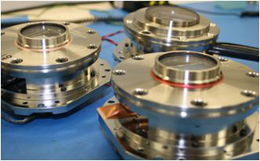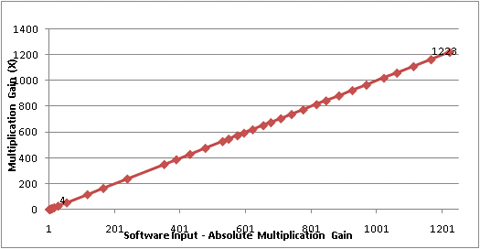|
ProEM+
Next-Generation,
Professional-Grade
EMCCD Cameras for
Scientific Imaging and Spectroscopy
Performance | Precision
Peace of Mind
|
 |
|
 Visit the eXcelon page for Visit the eXcelon page for
more information
|
|
|
Available with our revolutionary software:
|
|
|
ProEM+ Re-imagined for Even Greater Performance and Flexibility
Available Imaging and Spectroscopy Models and Formats
ProEM EMCCD Camera models comparison and datasheets
B/I = Back Illuminated
FT = Frame Transfer
 ProEM+ Key Features and Benefits
ProEM+ Key Features and Benefits
Cooling

ProEM+ uses the most advanced vacuum and cooling technology with all-metal hermetic seals
All-metal seals: Good vacuum is key to achieving deep cooling and consequently low dark noise. Traditional epoxy based seals degrade over time and compromise vacuum performance due to out-gassing. In contrast, Princeton Instruments’ proprietary all-metal sealed design provides highest level of vacuum performance, year after year. Even the vacuum window -the only optical surface in the optical path, is brazed (fused at molecular level) to the vacuum chamber.
Permanent vacuum guarantee: ProEM+ comes with PI’s lifetime vacuum guarantee. It is the only such guarantee of its kind in the industry. It is backed by advanced vacuum technology and thousands of cameras in the field!
Options: Options galore! Say good-bye to compromises. ProEM+ delivers the highest performance using air, liquid or a combination thereof.
Air only: Most convenient of all - just connect the camera and go. ProEM+ is cooled using a built-in, low-noise fan.
Liquid only: In vibration sensitive applications such as microscopy, any moving parts, such as internal fans, create vibration. Astronomy applications require that there be no air turbulence around the telescope optics which can cause defocusing. Liquid only cooling method eliminates heat and vibration while achieving maximum cooling performance. This is superior to temporarily turning off the fan, which compromises the cooling stability over long periods.
Air+Liquid: When your application requires all the cooling and the lowest dark noise - use cold liquid circulation and the built-in fan in ProEM+ to get even better cooling and reduce dark current.
Low Noise
PINS (Princeton Instruments Noise Suppression technology): Princeton Instruments' engineers have used the next generation electronics to get the lowest possible noise levels in ProEM+. In EM mode, the ProEM+ delivers the lowest starting read noise of any camera in the market –an advantage considering only a small amount of EM gain is required to achieve <1 e- rms effective read noise.
Return to top of page

For traditional readout port, the camera delivers 3 e- rms read noise at 100kHz, an unparalleled performance. Now, whether it is fast or slow application, the ProEM+ delivers the lowest noise combination ever to be achieved. Part of the technology also includes proprietary methods to reduce clock induced charge –an unwanted noise source in EM applications requiring single photon detection. It is reduced to 0.005 e-/p/frame with careful optimization of clock timing and voltage levels on every camera.
Sensitivity
Back illuminated EMCCD: At the heart of ProEM+ is a back-illuminated EMCCD that delivers greater than 90% quantum efficiency and less than 1 e- rms read noise when electrons generated in each pixel (from the incident photons) via impact ionization.
Single window vacuum design: The double sided, anti-reflection coated vacuum window is the only optical surface between incoming photons and highly sensitive CCD surface. A choice of AR coatings are available to get the best throughput from UV to NIR.

ProEM+ uses only one optical window that can be custom AR coated for high throughput
Traditional CCD or “Non-EM” mode: While the EM mode is ideal for low light, high speed imaging applications, the non-EM or traditional readout amplifier is the best for slow scan applications - for example, astronomical imaging requiring minutes to hours of exposures. By reading out slowly, ProEM+ delivers 3 e- rms read noise at 100kHz even in non-EM mode.

Non-EM mode offers the best SNR for steady state applications requiring long integration times
Return to top of page
Options
Numerous options - No more compromises! ProEM+ delivers the highest performance using air, liquid or a combination thereof. The cameras can be cooled below -95°C for the lowest dark noise. For traditional readout port, the camera delivers 2.5 to 3 e- rms read noise at 100kHz, an unparalleled performance. Now, whether it is fast or slow application, the ProEM+ delivers the lowest noise combination ever achieved.
Part of the technology also includes proprietary methods to reduce clock induced charge –an unwanted noise source in EM applications requiring single photon detection. It is reduced to 0.005 e-/p/frame with careful optimization of clock timing and voltage levels on every camera.
Speed
Video frame rates and up: ProEM+ provides better than video rate even at full resolution (512x512). But if you need hundreds of frames per second, a combination of binning and region of interest (ROI) can be used. For even higher frame rate, a “custom chip” mode allows 3 to 4 times higher frame rate when only a partial area of the CCD is illuminated.
It is all delivered to the host computer on the latest gigabit ethernet (GigE) interface –a first for a scientific EMCCD camera. ProEM+ implements precision time stamp feature –another first!
Kinetics: Need to capture a process with microsecond time resolution or at millions of frames per second in a burst? ProEM+ fully supports Kinetics -a special readout mode - right out of the box. By illuminating only a small portion of the sensor, a series of sub-frames can be captured and shifted in microseconds vastly increasing the time resolution.

ProEM+ offers Kinetics readout mode for microsecond time resolution. The mode requires that only a partial area is illuminated
Variable Vertical transfer time: The vertical transfer time –which determines the smear and affects frame rate – can be varied from 300nsec and up, through software control.
Return to top of page
Precision
OptiCAL: EM calibration gone optical! A precision light source built into every camera is used to generate a linearized EM gain map on demand by the user. In the software, you are controlling the EM gain in absolute steps. In other words, What You See is What You Get!
ProEM+ uses a built-in precision light source for accurate, linear calibration of EM gain.

BASE: Bias Active Stability Engine. Whether you are acquiring images over hours or days, BASE allows you to achieve consistent, repeatable reference bias.
Mechanical shutter: While the frame transfer architecture of ProEM+ EMCCDs does not require a mechanical shutter for normal operation, it is very helpful when you need to block external light to acquire reference background images. ProEM+ comes with a built-in mechanical shutter for capturing dark references and protecting the sensor from dust or debris.
Vibration-free: ProEM+ was designed from the beginning for ultra-sensitive setups such as microscopy and ion imaging which require that there be no vibration introduced in the system. Simply turn off the fan permanently and use liquid cooling.
Heat Free: Another added benefit to “Liquid only” cooling -the heat is carried away from the camera without generating air turbulence around sensitive optics such as telescopes.
Time Stamp: No more guessing on when an image is actually captured. Traditionally, time stamping is done on the host computer using low precision CPU clock. In contrast, ProEM+ actually stamps the frame data with precise time of capture with usec resolution. It is essential for measuring fast kinetics over time.
Peace of Mind
Permanent vacuum guarantee: we back every Pro EM camera’s vacuum for life of the camera –the only such guarantee in the industry. It is backed by PI’s all-metal sealed design, years of experience in deep cooled technology and thousands of cameras in the field.
Anti-ageing: It is true that EM gain can degrade over time especially when a large gain is used in high light conditions. ProEM+ uses every anti-ageing measure including clock voltage optimization to reduce the effect of ageing. The deep cooling allows the high voltage clocks to be operated well below the maximum ratings, while still achieving greater than 1000x EM gain.
Worldwide support: Princeton Instruments is a recognized name in the scientific community. With years of application expertise and low light camera technology, our worldwide representatives are ready provide the best solution to the most demanding applications!
|

